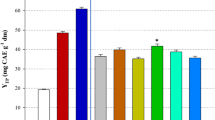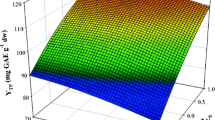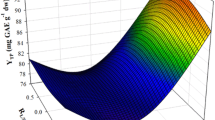Abstract
Olive leaf, an agricultural by-product, was studied for the valorization of its biophenols using green extraction techniques; i.e. non-toxic and eco-friendly extraction solvents were used, involving water and glycerol. 2-hydroxypropyl-β-cyclodextrin (CD), was also employed as an enhancer of the extraction, since cyclodextrins (CD’s) are known to improve the extractability of olive leaf polyphenols by forming water soluble inclusion complexes. The process was optimized by implementing a central composite (Box-Behnken) experimental design and response surface methodology, taking into consideration the following independent variables: glycerol concentration (C gl), CD concentration (C CD) and temperature (T). The evaluation of the extraction model was based on two responses: the total polyphenol yield (YTP) and the antiradical activity (AAR). Optimum values for the extraction process were obtained at 60% (w/v) glycerol content, T = 60 °C and 7% (w/v) CD content. LC–MS analysis was also applied in order to characterize the polyphenolic composition of extracts containing cyclodextrins. The main polyphenols present were oleuropein and oleuropein derivatives. Olive leaf aqueous extracts containing glycerol and cyclodextrins may be used as raw materials/ingredients for several end-users in the food, cosmetic and pharmaceutical industries.



Similar content being viewed by others
References
Agourram A, Ghirardello D, Rantsiou K, Zeppa G, Belviso S, Romane A, Giordano M (2013) Phenolic content, antioxidant potential, and antimicrobial activities of fruit and vegetable by-product extracts. Int J Food Prop 16(5):1092–1104
Ahmad-Qasem MH, Cánovas J, Barrajón-Catalán E, Micol V, Cárcel JA, García-Pérez V (2013) Kinetic and compositional study of phenolic extraction from olive leaves (var. Serrana) by using power ultrasound. Innov Food Sci Emerg Technol 17:120–129
Apostolakis Α, Grigorakis S, Makris DP (2014) Optimisation and comparative kinetics study of polyphenol extraction from olive leaves (Olea europaea) using heated water/glycerol mixtures. Sep Purif Technol 128:89–95
Attya M, Benabdelkamel H, Perri E, Russo A, Sindona G (2010) Effects of conventional heating on the stability of major olive oil phenolic compounds by tandem mass spectrometry and isotope dilution assay. Molecules 15:8734–8746
Bassil D, Makris DP, Kefalas P (2005) Oxidation of caffeic acid in the presence of l-cysteine: isolation of 2-S-cysteinylcaffeic acid and evaluation of its antioxidant properties. Food Res Int 38:395–402
Chemat F, Vian MA, Cravotto G (2012) Green extraction of natural products: concept and principles. Int J Mol Sci 13(7):8615–8627
Đorđević V, Balanč B, Belščak-Cvitanović A, Lević S, Trifković K, Kalušević A, Nedović V (2014) Trends in encapsulation technologies for delivery of food bioactive compounds. Food Eng Rev 7:452–490
El-Baroty GS, Khalil MF, Mostafa SHA (2014) Natural antioxidant ingredients from by-products of fruits. Am J Agric Biol Scie 9(3):311–320
Karakashov B, Grigorakis S, Loupassaki S, Makris DP (2015) Optimization of polyphenol extraction from Hypericum perforatum (St. John’s Wort) using aqueous glycerol and response surface methodology. J Appl Res Med Aromat Plants 2:1–8
Karvela E, Makris DP, Karathanos VT (2012) Implementation of response surface methodology to assess the antiradical behaviour in mixtures of ascorbic acid and α-tocopherol with grape (Vitis vinifera) stem extracts. Food Chem 132:351–359
Kyriakidou K, Mourtzinos I, Biliaderis CG, Makris DP (2016) Optimization of a green extraction/inclusion complex formation process to recover antioxidant polyphenols from oak acorn husks (Quercus Robur) Using Aqueous 2-Hydroxypropyl-b-Cyclodextrin/Glycerol Mixtures. Environments 3:1–11
Li Y, Fabiano-Tixiera AS, Tomao V, Cravotto G, Chemat F (2013) Green ultrasound-assisted extraction of carotenoids based on the bio-refinery concept using sunflower oil as an alternative solvent. Ultrason Sonochem 20:12–18
Lockyer S, Rowland I, Edward Spencer JP, Yaqoob P, Stonehouse W (2016) Impact of phenolic-rich olive leaf extract on blood pressure, plasma lipids and inflammatory markers: a randomized controlled trial. Eur J Nutr. doi:10.1007/s00394-016-1188-y
Makris DP, Boskou G, Andrikopoulos NK (2007) Polyphenolic content and in vitro antioxidant characteristics of wine industry and other agri-food solid waste extracts. J Food Comp Anal 20:125–132
Martins A, Barros L, Carvalho AM, Santos-Buelga C, Fernandes IP, Barreiro F, Ferreira ICFR (2014) Phenolic extracts of Rubus ulmifolius Schott flowers: characterization, microencapsulation and incorporation into yogurts as nutraceutical sources. Food Funct 5(6):1091–1100
Mohammadi A, Jafari SM, Esfanjani AF, Akhavan S (2016) Application of nano-encapsulated olive leaf extract in controlling the oxidative stability of soybean oil. Food Chem 190:513–519
Mourtzinos I, Salta F, Yannakopoulou K, Chiou A, Karathanos VT (2007) Encapsulation of olive leaf extract in beta-cyclodextrin. J Agric Food Chem 55(20):8088–8094
Mylonaki S, Kiassos E, Makris DP, Kefalas P (2008) Optimisation of the extraction of olive (Olea europaea) leaf phenolics using water/ethanol-based solvent systems and response surface methodology. Anal Bioanal Chem 392:977–985
Pinho E, Grootveld M, Soares G, Henriques M (2014) Cyclodextrins as encapsulation agents for plant bioactive compounds. Carbohydr Polym 101:121–135
Pinho E, Soares G, Henriques M (2015) Cyclodextrin modulation of gallic acid in vitro antibacterial activity. J Incl Phenom Macrocycl Chem 81:205–214
Rahmanian N, Jafari SM, Wani TA (2015) Bioactive profile, dehydration, extraction and application of the bioactive components of olive leaves. Trends Food Sci Technol 42:150–172
Ranalli A, Contento S, Lucera L, Di Febo M, Marchegiani D, Di Fonzo V (2006) Factors affecting the contents of iridoid oleuropein in olive leaves (Olea europaea L.). J Agric Food Chem 54:434–440
Rodis PS, Karathanos VT, Mantzavinou A (2002) Partitioning of olive leaf antioxidants between oil and water phases. J Agric Food Chem 50:596–601
Rosello-Soto E, Koubaa M, Moubarik A, Lopes RP, Saraiva JA, Boussetta N, Grimi N, Barba FJ (2015) Emerging opportunities for the effective valorization of wastes and by-products generated during olive oil production process: nonconventional methods for the recovery of high-added value compounds. Trends Food Sci Technol 45:296–310
Shah MA, Bosco SJD, Mir SA (2014) Plant extracts as natural antioxidants in meat and meat products. Meat Sci 98(1):21–33
Shehata E, Grigorakis S, Loupassaki S, Makris DP (2015) Extraction optimization using water/glycerol for the efficient recovery of polyphenolic antioxidants from two Artemisia species. Sep Purif Technol 149:462–469
Singh I, Mok M, Christensen AM, Turner AH, Hawley JA (2008) The effects of polyphenols in olive leaves on platelet function. Nutr Metab Cardiovasc Dis 18:127–132
Singh B, Sharma HK, Sarkar BC (2012) Optimization of extraction of antioxidants from wheat bran (Triticum spp.) using response surface methodology. J Food Sci Technol 49:294–308
Talhaoui N, Gómez-Caravaca AM, León L, De la Rosa R, Segura-Carretero A, Fernández-Gutiérrez A (2014) Determination of phenolic compounds of ‘Sikitita’ olive leaves by HPLC-DAD-TOF-MS. Comparison with its parents ‘Arbequina’ and ‘Picual’ olive leaves. LWT: Food Sci Technol 58:28–34
Visioli F, Galli C (1998) The effect of minor constituents of olive oil on cardiovasculardisease: new findings. Nutr Rev 56:142–147
Volf I, Ignat I, Neamtu M, Popa VI (2014) Thermal stability, antioxidant activity, and photo-oxidation of natural polyphenols. Chem Pap 68:121–129
Xynos N, Papaefstathiou G, Psychis M, Argyropoulou A, Aligiannis N, Skaltsounis A-L (2012) Development of a green extraction procedure with super/subcritical fluids to produce extracts enriched in oleuropein from olive leaves. J Supercrit Fluids 67:89–93
Author information
Authors and Affiliations
Corresponding author
Electronic supplementary material
Below is the link to the electronic supplementary material.
Rights and permissions
About this article
Cite this article
Mourtzinos, I., Anastasopoulou, E., Petrou, A. et al. Optimization of a green extraction method for the recovery of polyphenols from olive leaf using cyclodextrins and glycerin as co-solvents. J Food Sci Technol 53, 3939–3947 (2016). https://doi.org/10.1007/s13197-016-2381-y
Revised:
Accepted:
Published:
Issue Date:
DOI: https://doi.org/10.1007/s13197-016-2381-y




